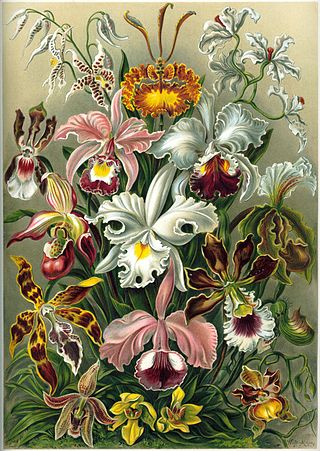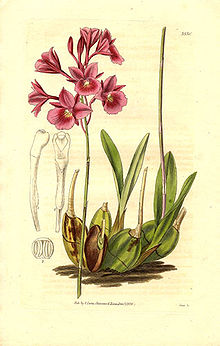
Scilloideae is a subfamily of bulbous plants within the family Asparagaceae. Scilloideae is sometimes treated as a separate family Hyacinthaceae, named after the genus Hyacinthus. Scilloideae or Hyacinthaceae include many familiar garden plants such as Hyacinthus (hyacinths), Hyacinthoides (bluebells), Muscari and Scilla and Puschkinia. Some are important as cut flowers.

Laelia is a small genus of 25 species in the orchid family (Orchidaceae). Laelia species are found in areas of subtropical or temperate climate in Central and South America, but mostly in Mexico. Laelia is abbreviated L. in the horticultural trade.

The taxonomy of the Orchidaceae (orchid family) has evolved slowly during the last 250 years, starting with Carl Linnaeus who in 1753 recognized eight genera. De Jussieu recognized the Orchidaceae as a separate family in his Genera Plantarum in 1789. Olof Swartz recognized 25 genera in 1800. Louis Claude Richard provided us in 1817 with the descriptive terminology of the orchids. (See External links below). The next step was taken in 1830-1840 by John Lindley, who recognized four subfamilies. He is generally recognized as the father of orchid taxonomy. The next important step was taken by George Bentham with a new classification, recognizing subtribes for the first time. This classification was first presented in a paper that Bentham read to the Royal Society in 1881. Then it was published in 1883 in the final volume of Genera Plantarum. The next great contributors were Pfitzer (1887), Schlechter (1926), Mansfeld (1937), Dressler and Dodson (1960), Garay (1960, 1972), Vermeulen (1966), again Dressler (1981). and Burns-Balogh and Funk (1986). Dressler's 1993 book had considerable influence on later work.

The Orchidoideae, or the orchidoid orchids, are a subfamily of the orchid family (Orchidaceae) that contains around 3630 species. Species typically have a single (monandrous), fertile anther which is erect and basitonic.

Cattleya trianae, also known as Flor de Mayo or "Christmas orchid", is a plant of the family Orchidaceae. It grows as an epiphytic orchid, with succulent leaves, endemic to Colombia where it was nominated as the national flower in November 1936. That year, the National Academy of History of Argentina asked the Latin American countries to participate in an exhibition with the representative flowers of each country. The Colombian government gave the botanist Emilio Robledo the task to designate the most representative flowering plant of the country.

Coilostylis ciliaris, formerly Epidendrum ciliare, is a species of orchid in the genus Coilostylis. It was transferred from Epidendrum by Withner and Harding in 2004. It is the type species of the genus Coilostylis.

Epidendrum difforme is a species of orchid in the genus Epidendrum. In 1861, Müller classified this species in the subsection Umbellata of the section Planifolia of subgenus EuepidendrumLindl. of the genus Epidendrum.

Epidendrum magnoliae, sometimes called Epidendrum conopseum or the green-fly orchid, is a species of orchid in the genus Epidendrum. It is the most northern-growing epiphytic orchid in North America, being found wild in the southeastern United States from Louisiana to North Carolina, and also in northeastern Mexico.

Epidendrum nocturnum is the type species of the genus Epidendrum of the Orchidaceae . The species occurs in Florida, Bahamas, West Indies, Belize, Central America to northern Brazil and the Guyanas. Epidendrum nocturnum is common in South Florida.

Brassavola cucullata, common name daddy long-legs orchid, is a species of orchid native to Mexico, Belize, Central America, the West Indies and northern South America.

Cattleya forbesii, or Forbes' cattleya, is a species of orchid. The diploid chromosome number of C. forbesii has been determined as 2n = 54–60.

Cattleya granulosa is a bifoliate Cattleya species of orchid. It is endemic to Brazil; the type specimen was reported to come from Guatemala, but this is likely erroneous. The diploid chromosome number of C. granulosa has been determined as 2n = 40.

Cattleya guttata is a bifoliate Cattleya species of orchid. The diploid chromosome number of C. guttata has been determined as 2n = 40.

Cattleya intermedia, the intermediate cattleya, is a bifoliate Cattleya species of orchid. The diploid chromosome number of C. intermedia has been determined as 2n = 40.

Cattleya mossiae, commonly known as the Easter orchid, is a species of labiate Cattleya orchid. The white-flowered form is sometimes known as Cattleya wagneri. The diploid chromosome number of C. mossiae has been determined as 2n = 40. The haploid chromosome number has been determined as n = 20.

Cattleya walkeriana, or Walker's cattleya, is a species of orchid. It differs from most species of Cattleya by having inflorescences which arise from the rhizome instead of from the apex of the pseudobulb. In its native habitat it grows as either an epiphyte or a lithophyte, sometimes in full sun. Pseudobulbs are relatively short, bulbous or fusiform, with one or two ovate leaves at the apex. Inflorescence is one- or few-flowered, about 8" (20 cm) tall. Flowers are 4-5" (9-12 cm) across.

Cattleya warscewiczii, a labiate Cattleya, is a species of orchid.

Jacquiniella is a genus of flowering plants from the orchid family, Orchidaceae. It is native to Mexico, Central America, the West Indies, and South America.

Dr Maarten Joost Maria Christenhusz is a Dutch botanist, natural historian and photographer.

Cattleya elongata, the "cattleya with the elongated stalk", is an orchid species in the genus Cattleya endemic to the campo rupestre vegetation in northeastern Brazil.

























